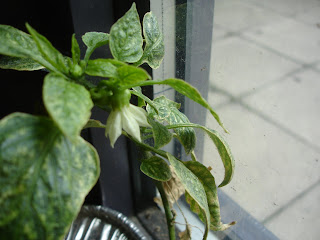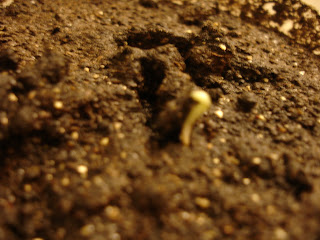








It's been a while since I last posted here. Since then, I have moved out of my college dorm and relocated the plants to a fair and sunny lawn in the suburbs. I left them in containers, however, because I plan on moving them again in a few months. There have been many other changes and lessons taken throughout the many weeks that I haven't posted.
First, sadly, the apple seed I was planting grew to about a centimeter and then suddenly started to shrivel up and die. Theories abound as to the cause of death, ranging from not enough sunshine (I only moved it to a sunny spot a few days after it poked out of the ground), unsuitable soil (although that's probably false, since I used potting soil, which the other apple seed grew in), and poor genetics (feasible, but I'm skeptical, since the apple seed did in fact germinate). I will need to find more apple seeds to plant, or else my original apple tree will neither be able to cross-pollinate nor bear edible fruit.
On the issue of the importance of sunshine, I think I just realized the extent of it. Between the time that I moved the plants out of the city and settled them outside in the sunshine, they were sitting in my shadowy room. Mere days after bringing them inside, all sorts of things went wrong. For instance, the leaves that the tall avocado tree sprouted weeks prior suddenly shriveled up and fell off. The other large avocado tree began to consume the energy in its pit, causing it to turn dark brown and contract. The tomatoes also started to sag, and some of the peppers died. The apple tree also lost a few leaves. That's when I realized I had to put the plants outside. Since then, I've seen improvements. The apple tree approximately doubled its height, growing larger and greener leaves. Everything looks more or less healthy.
But the most dramatic effects were manifest in those plants that got more soil as well. Three weeks ago I had to leave the country and, being in a huge rush, I simply pulled the basil plants out of the soil and threw them in a box filled with potting soil. Covering the plants with some soil and drenching them in water, I assumed that most, or nearly all, of the (tiny) basil plants would die. Coming back today, I found that, indeed, only a handful of plants survived. However, these plants were absolutely massive compared to their original size. They must have multiplied their mass by at least fifty times in those three weeks. The combination of plentiful earth and abundant sunshine really worked wonders on these plants.
Similarly, most of the pepper plants died, as I mentioned before. The remaining plants therefore had a bigger share of the soil and, combined with some great sun, tripled or quadrupled their size. I also moved some of the tomato plants (only the ones that were in a small cup and looked sick and purple) to a larger container with more soil. They also grew a substantial amount while I was gone.
To be exact, this "soil" was dug from the side of a very minor creek, underneath some large trees and flanked by man-made concrete walls. Over the years, there has accumulated a large and smelly black mass of rotting leaves and many, many earthworms by this creek, since there is nothing to remove the compost from between the concrete walls. With the help of a friend, I used this (presumably) nutrient-rich (and oxygen-poor) compost as soil for the small tomato plants and also for the large avocado plants.
While I saw improvements in the small tomato plants, the avocados look pretty much the same. In some ways, they even look worse. For example, some of the leaves on one of the plants have turned yellow or even white in parts. I don't know what is wrong with the plants. I don't think that the problem is too intense sunlight, as so far it has only helped the other plants apparently. Perhaps I didn't cover the roots of the plants enough. Or maybe the soil is not appropriate for the avocados. Maybe they need more oxygen in the roots, or just sandier soil.
Some questions remain, but overall I have learned two important lessons. First, plants usually benefit from strong sunshine, and can die if they are without it for even a few days. Second, plants usually do not grow past a certain height if they are limited in the soil they can occupy. Hopefully this summer will provide an opportunity for the plants to grow substantially.






































